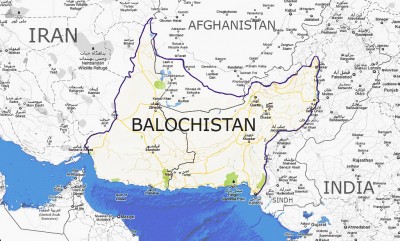The true history of Balochistan is never shared or talked about among the general public of Pakistan

Balochistan consists of the south west of Pakistan. In the west it borders with Afghanistan and Iran and in the south it has the Arabian Sea. It accounts for nearly half the land mass of Pakistan and only 3.6% of its total population. The province is immensely rich in natural resources, including oil, gas, copper and gold. Despite these huge deposits of mineral wealth, the area is one of the poorest regions of Pakistan.
...
Read more »
Category:
History
|
Views:
346
|
Added by:
drmarri
|
Date:
15.06.2017
|
|
 Lalkhan was my great great grandfather, who was first among the Marri who charged the British in May and August 1840 the British detachments were wiped out by the Marris in Battles of Sartaaf and Nafusk respectively... Lalkhan was my great great grandfather, who was first among the Marri who charged the British in May and August 1840 the British detachments were wiped out by the Marris in Battles of Sartaaf and Nafusk respectively...
His both arms were badly wound in first battle with the British in May 1840 at Sartaaf in Marri hills but he survived to fight again at August 1840 again heavily defeating the British.
Again in 1859 and 1862 Lalkhan's younger brother LalBeag joint the Marris who fought decisive battles at Mawand and defeated the joint forces of Mir Khudadad Khan of Kalat and British.
...
Read more »
Category:
History
|
Views:
576
|
Added by:
drmarri
|
Date:
24.04.2017
|
|

The dancing men
By: Aziz Kingrani
Anyone entering Balochistan province from any direction is sure to be caught by the eye-catching and magnetic natural beauty, as the entire area looks like a holiday resort with unique natural attractiveness. Its vast coastal area, wonderful mountainous valleys, arresting waterfalls, undefeatable high mountain ranges and hillocks, stunning springs and climate makes one feel like staying there forever.
Ancient remains of life and civilisation can be found in Balochistan, as water, being a basic necessity of life, existed in the vales and mountains, while some remains of archaeological sites and cave paintings have been found in Balochistan.
Several sites of cave paintings on rocks have been registered in upper Balochistan but the sites of cave paintings of lower Balochistan are still unexplored — for instance the cave paintings of Tharia cave in Pabu mountain near Qili (village) Chatoka Bhit (mound) in the valley of Pallimas, Tahseel Wadh, Khuzdar District, which I visited this year in March.
...
Read more »
Category:
History
|
Views:
421
|
Added by:
drmarri
|
Date:
22.03.2017
|
|

By: Shah Nawaz Marri
Mir Hazar Khan Ramkani Marri is son of Mukhadam Gula Khan Marri. Gula Khan was the traditional head of the Ramkani section of the Bijarani branch of Marris. The Marris are divided into three main sections, the Gazainis, the Bijaranis and the Loharanis. Each of these sections is then divided into sub-sections.
The Sardars of the tribes historically was rotatory and elections were held between different tribes Mukhadams for sardari, it became part of Gazaini section after the intervention of the British, even after this the Marri tribe is of democratic structure the Sardar is the first among equals. Each Marri tribesman has a standing and a voice in Marri society. The Sardar or the clan chief cannot and will not ever insult a Marri and it is because of this mutual respect the loyalties of a Marri to his Sardar or clan leader is phenomenal.
The Ramkani Marris live in central Marri area of Tadri, a rugged area with good grazing grounds and man-made terraces for farming. They are like all tribesmen simple and hardworking. Gula Khan was son of Alo Khan who was son of Lal Khan. His uncle Inamo, a brave man, carried scars on his face of a hand to hand fight with a mountain leopard in his youth. Lal Khan is buried at Pir Darra on Tadri Mountain and is considered a saint by all Marri and many other Baloch tribes.
...
Read more »
Category:
History
|
Views:
754
|
Added by:
drmarri
|
Date:
08.03.2017
|
|

By: Dr. Jumma Khan Marri
Balochistan and Baloch
"Balochistan" means the land of the Baloch. It is located on the south-eastern Iranian plateau between the Indian sub-continent and Central Asia. Balochistan is divided politically between Pakistan, Iran and Afghanistan.
The Anglo-Iranian border commission gave a large portion of south-western Balochistan to Iran in 1871 and to Afghanistan in 1895. The rest was part of British India, and as such was incorporated into the newly independent Pakistan after partition in 1947. Ignoring present-day political boundaries, Balochistan would cover approximately 225 000 square miles. It supports a population of about six million (1996).
It is an arid, harsh land with rugged terrain, ranging from steppe to desert, intersected by many mountain ranges. There are few permanent sources of water as rainfall is very low. Most rivers are seasonal, being fed by floodwater and the melted snow from the mountains.
...
Read more »
Category:
History
|
Views:
1903
|
Added by:
drmarri
|
Date:
15.02.2017
|
| |